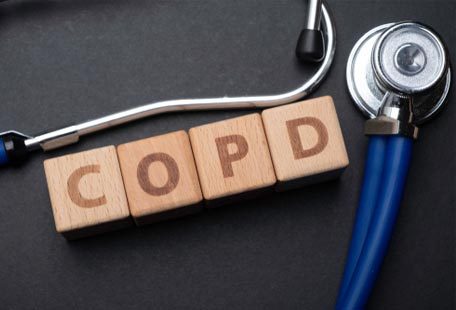COPD
 COPD
FAST FACTS
COPD
FAST FACTS
COPD is incurable but with timely diagnosis and treatment, symptoms can be controlled.
- There are 251 million COPD Patients Globally.
- COPD prevalence in the Middle East is 3.7-5.3% and 4.9% in the UAE.

 WHAT IS COPD?
WHAT IS COPD?
 The cause of developing COPD is long-term
exposure to irritating gases or particulate matter,
most often from cigarette smoke. People with
COPD are at an increased risk of developing
heart disease, lung cancer as well as variety of
other conditions.
The cause of developing COPD is long-term
exposure to irritating gases or particulate matter,
most often from cigarette smoke. People with
COPD are at an increased risk of developing
heart disease, lung cancer as well as variety of
other conditions. Whilst chronic bronchitis is inflammation of the
lining of the tubes that carry air to and from the air sacs (alveoli) of the lungs,
emphysema is a condition in which the alveoli
at the end of the smallest air passages
(bronchioles) of the lungs are destroyed.
Both conditions result in COPD, but with proper
management, most patients can achieve good
symptom control and quality of life, as
well as reduced risk of other associated
conditions.
Whilst chronic bronchitis is inflammation of the
lining of the tubes that carry air to and from the air sacs (alveoli) of the lungs,
emphysema is a condition in which the alveoli
at the end of the smallest air passages
(bronchioles) of the lungs are destroyed.
Both conditions result in COPD, but with proper
management, most patients can achieve good
symptom control and quality of life, as
well as reduced risk of other associated
conditions.
Table between healthy and unhealthy airway:
| Healthy Airways | Unhealthy Airways |
|---|---|
| Healthy smooth muscles | Inflammation and excess sputum |
| Normal bronchial tube | Airways with bronchitis |
| Open airways | Air sacs break down |
| Healthy air sacs | Air sacs with emphysema |
 COPD SYMPTOMS
COPD SYMPTOMS
 Symptoms of COPD include:
Symptoms of COPD include:
- Daily cough with mucus production
- Shortness of breath
- Frequent respiratory infections
- Wheezing
- Chest tightness
- Lack of energy
- Morning cough
- Swelling in ankles, feet or legs
- Blueness of the lips or fingernail beds
- Unintended weight loss
- Chronic cough that may produce clear, white, yellow or greenish mucus
 A COPD exacerbation is when your
symptoms suddenly flare-up; this can last for several days.
A COPD exacerbation is when your
symptoms suddenly flare-up; this can last for several days.

 How do WE treat COPD
How do WE treat COPD
 Asthma can’t be cured, but its symptoms can be controlled. Because asthma often changes over time, it’s important that you work with your doctor to track your signs and symptoms and adjust treatment as needed.
Asthma can’t be cured, but its symptoms can be controlled. Because asthma often changes over time, it’s important that you work with your doctor to track your signs and symptoms and adjust treatment as needed.
 Managing Your COPD
Managing Your COPD
Quitting both active or passive smoking is best to prevent damage to your lungs.
- Bronchodilators
- Antibiotics
- Anti-inflammatory medicines
- Vaccination
- Pulmonary rehabilitation
- Oxygen therapy
 Monitoring Your COPD
Monitoring Your COPD
The COPD Assessment Test (CAT) will help you and your doctor to understand the impact that COPD is having on your wellbeing and daily life. Your responses and the test score will be used by you and your healthcare professional to help improve the management of your COPD and gain the greatest benefit from treatment. To take the test, please click here.
 DO’s and DON’Ts
DO’s and DON’Ts
 Asthma can’t be cured, but its symptoms can be controlled. Because asthma often changes over time, it’s important that you work with your doctor to track your signs and symptoms and adjust treatment as needed.
Asthma can’t be cured, but its symptoms can be controlled. Because asthma often changes over time, it’s important that you work with your doctor to track your signs and symptoms and adjust treatment as needed.
The key to living with asthma successfully is to keep it under control. Limit contact with asthma triggers in your environment, monitor your condition with a peak flow meter, and follow your treatment plan strictly.
Work on reducing asthma triggers. A first step is to stop smoking and protect yourself second-hand smoke in your home and in public places.
It is possible to be active and stay healthy when you’re living with asthma. In fact, many medal-winning Olympic athletes have asthma. Exercise strengthens your respiratory muscles, helps maintain weight.Exercises that are less likely to trigger asthma symptoms include swimming, walking, hiking, and leisurely biking. Sports that have short bursts of activity are also less likely to set off symptoms. Examples include baseball, football, and sprinting.
You may have to pace yourself at times or make some adjustments here or there, such as avoiding outdoor sports in the early morning, when pollen counts are at their highest (assuming pollen is one of your triggers).
Useful Material
Coming Soon
CONNECT WITH THE LEADERS IN THE SOCIETY










